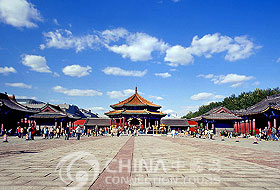Liaoning Province, situated in the south of northeast China, borders the Yellow Sea (Korea Bay) and the Bohai Gulf in the south, North Korea in the southeast, Jilin Province to the northeast, Hebei Province to the west, and Inner Mongolia to the northwest.
The Yalu River marks the border between North Korea and the Chinese provinces of Jilin and Liaoning. It empties into Korea Bay between Dandong (Liaoning) and Sinŭiju (North Korea). Liaoning can be viewed as three approximate geographical regions: the highlands in the west, plains in the middle, and hills in the east. The highlands in the west are dominated by the Nulu'erhu Mountains, which roughly follow the border between Liaoning and Inner Mongolia. The entire region is dominated by low hills. The central part of Liaoning consists of the watersheds of rivers such as the Liao, Daliao, and their tributaries. This region is mostly flat and at a low altitude.
The eastern part of Liaoning is dominated by the Changbai Shan and Qian Shan ranges, which extends into the sea to form the Liaodong Peninsula. The highest point in Liaoning, Mount Huabozi (1336 m), is found in this region.
Liaoning has a continental monsoon climate with distinct seasonal variations. The annual average rainfall is about 440 to 1130 mm and annual average temperature of 4C-10C with a frost-free period of 140-200 days. Summer is rainy while the other seasons are dry.
The Qin and Han dynasties were able to establish rule over much of what is Liaoning Province; later on Shenyang Imperial Palace governments headed by various peoples such as the Xianbei, Goguryeo, Khitan and Jurchen ruled Liaoning. In the seventeenth century, the Manchus established their capital in modern Shenyang, Liaoning, before they conquered the rest of China and set up the Qing Dynasty in 1644. In the last half of the seventeenth century the imperial government recruited migrants from Shandong Province to settle the sparsely populated area. Many of the current residents of Liaoning trace their ancestry to these seventeenth century settlers. For the rest of the Manchu era, China's Northeast was off-limits to Han Chinese, and was ruled by three generals, one of whom, the General of Shengjing, ruled much of modern Liaoning.
In 1860, the Manchu government began to reopen the region to migration, which quickly resulted in Han Chinese becoming the dominant ethnic group in the region. In the twentieth century, the province of Fengtian was set up in what is Liaoning today. When Japan and Russia fought the Russo-Japanese War in 1904-1905, many key battles took place in Liaoning. During the Warlord Era in the early twentieth century, Liaoning was under the Fengtian Clique, including Zhang Zuolin and his son Zhang Xueliang; in 1931, Japan invaded and the area came under the rule of the Japanese-controlled puppet state of Manchukuo. The Chinese Civil War that took place following Japanese defeat in 1945 had its first major battles (the Liaoshen Campaign) in and around Liaoning.
At the founding of the People's Republic of China in 1949, Liaoning did not exist; instead there were two provinces, Liaodong and Liaoxi, as well as five municipalities, Shenyang, Luda, Anshan, Fushun, and Benxi. These were all merged together into "Liaoning" in 1954, and parts of former Rehe province were merged into Liaoning in 1955. During the Cultural Revolution Liaoning also took in a part of Inner Mongolia, though this was reversed later.
Liaoning was one of the first provinces in China to industrialize, first under Japanese occupation, and then even more in the 1950s and 1960s. The city of Anshan, for example, is home to one of the largest iron and steel complexes in China. In recent years this early focus on heavy industry has become a liability, as many of the large state-run enterprises have experienced economic difficulties. Recognizing the special difficulties faced by Liaoning and other provinces in Northeast China because of their heritage of heavy industry, the Chinese central government recently launched a "Revitalize the Northeast" Campaign.
The population of Liaoning is mostly Han Chinese with minorities of Manchus, Mongols, Hui, Koreans and Xibe.
 Liaoning has over 11,300 cultural remains, including 19 national-level key protection units and 159 provincial-level key protection units. There are seven state-class natural reserves and seven provincial-class natural reserves. The Mukden Palace was the palace of the Qing Dynasty emperors before they conquered the rest of China and moved their capital to Beijing. Though not as large nor as famous as its counterpart (the Forbidden City) in Beijing, the Mukden palace is significant for its representation of palace architecture at the time, and has recently been included on the UNESCO World Heritage Site as an extension of the Imperial Palace site in Beijing. Some of the folk festivals attract the attention of both domestic and foreign visitors such as the Dalian Costume Festival.
Liaoning has over 11,300 cultural remains, including 19 national-level key protection units and 159 provincial-level key protection units. There are seven state-class natural reserves and seven provincial-class natural reserves. The Mukden Palace was the palace of the Qing Dynasty emperors before they conquered the rest of China and moved their capital to Beijing. Though not as large nor as famous as its counterpart (the Forbidden City) in Beijing, the Mukden palace is significant for its representation of palace architecture at the time, and has recently been included on the UNESCO World Heritage Site as an extension of the Imperial Palace site in Beijing. Some of the folk festivals attract the attention of both domestic and foreign visitors such as the Dalian Costume Festival.

